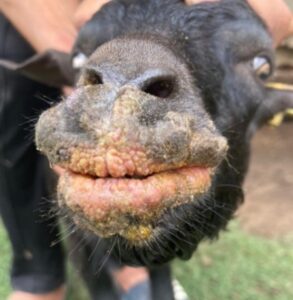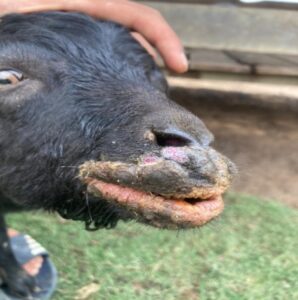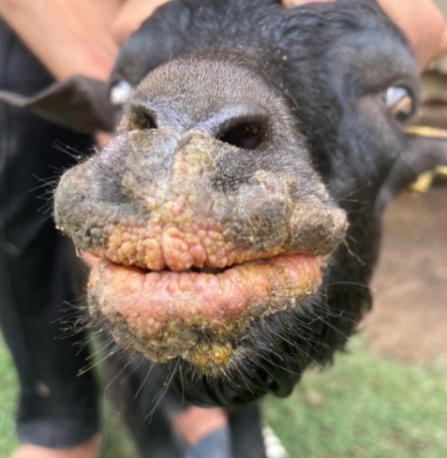Contagious Ecthyma (Orf) in Small Ruminants
K.Merina Devi1*, T. Gyaneshori Devi2 and N. Bhumapati3
1*Assistant Professor, Department of Livestock Farm Complex, COVSC & AH, Jalukie, Nagaland, India;
2Assistant Professor, Department of Livestock Production Management, COVSC & AH, Jalukie, Nagaland, India
3Assistant Professor, Department of Veterinary Gyanecology & Obstetrics, COVSC & AH, Jalukie, Nagaland, India
Key words: Orf, Zoonotic, Immunosuppression
Abstract: Orf, is an acute highly contagious, skin disease primarily observed in sheep, goat and other wild ruminants. It is a viral zoonotic disease affecting all age groups of animals; however, young or immunocompromised animals are more susceptible. The disease is transmitted either by direct/indirect contact with contaminated materials or exposure to contaminated environment, inanimate objects, equipment and fomites carrying the virus. Lesions are mostly concentrated in and around the lips, mouth, tongue, hard palate, oral mucosa, muzzle, on the teats of nursing ewe and does. It is a self-limiting disease which can completely be recovered within 1-2 months, however, in an unattended case, there may be maggot wound, fungal infestations and secondary bacterial infections which adds complication to the disease. The mobility rate of the disease may reach up to 100% while mortality is generally less. Being a viral disease, there is no specific treatment against orf, therefore, treatment is towards the control of secondary infections which may include administration of antibiotics, antiallergic, supportive treatment and application of ointment to the lesions. Adequate determination of pathophysiology, risk factors associated with the occurance of the disease, early detection and isolation of infected animal from the herd may help to minimize the incidence.
Introduction:
Orf, is an acute highly contagious and economically importance non-systemic viral skin disease primarily observed in sheep, goat, domesticated animals (camel, alpaca) and wild ruminants (reindeer, black buck, antelope). It is a zoonotic disease which means it can easily be transmitted to animals to men and is caused by Parapoxvirus (Murphy et al., 2012). It is a self-limiting disease and affects all age groups of animals; however, young or immunocompromised animals are more susceptible. The disease is more severe in goats than in sheep (Nandi et al., 2011). The disease is known with 80 medical names and more oftenly known as contagious pustular dermatitis, contagious ecthyma, sore mouth, scabby mouth, infectious labial dermatitis, thistle disease etc. The word Orf in old English means Rough and Tough (Maclachlan and Dubovi, 2010) and when the disease occurs in human, it is more popularly known as Orf (Nourani and Maleki, 2006). The economic importance of the disease is that there is risk of lower productivity and body weight gain of animals due to stress, reduces the market weight of meat, wool, leather etc.
Transmission:
The disease is commonly found in pasture or manual feeding under drought conditions. It is transmitted to animals or human through broken/damaged/infected areas either by direct/indirect contact with contaminated materials or exposure to contaminated environment, inanimate objects, equipment and fomites carrying the virus. The virus can remain on the wool and hides for approximately one month even after the wound have healed.
Signs and symptoms of disease:
The lesions are normally benign (Kassa, 2021) and appears after an incubation period of 3 to 7 days. Lesions are mostly concentrated in and around the lips, mouth, tongue, hard palate, oral mucosa, muzzle, on the teats of nursing ewe and does. The lesions usually resolved within 1-2 months (Nandi et.al., 2011), however, in an unattended case, there may be maggot wound, fungal infestations and secondary bacterial infections which adds complication to the disease. The mobility rate of the disease may reach up to 100% while mortality is generally less than 1%. Although, mortality rate in small ruminants due to secondary infections may reach as high as 20-50 % (Haig and Mercer, 1998) stress, immunosuppression or concurrent disease (Hosamani et al., 2009). Mortality in young animals may be inability of the kids to feed due to pain leading to anorexia; associated with maggot infestations and secondary bacterial infections


Fig: Contagious Ecthyma lesion in goat
Diagnosis:
Contagious Ecthyma can be diagnosed based on the characteristics and location of the lesions. However, confirmatory diagnosis can be done on isolation of virus and immunological test.
Treatment:
As there is no specific treatment against orf due to the fact that it is a viral disease, therefore, treatment is towards the control of secondary infections with antibiotics, supportive treatment to enhance immunity of the hosts (CertAH et. al.,2014). Topical application of specific ointment having wound healing property in affected areas will enhance the healing process by combating secondary infections. At present, there is no vaccine available for orf.
Prevention and control:
- Sick animals should be isolated from the herd.
- Frequent cleaning and disinfection of the animal shed should be done.
- Always wear gloves while handling the infected animals
- Contaminated materials and all tissues should be incinerated to prevent infection to other animals.
- When the lesion is in nipple, the young ones should be isolated from mother and fed artificially.
- Strict biosecurity measures in and around the farm area should be done.
Conclusion:
The orf infection can persists in a herd and may create economic loss to the farmers.The disease has gained popularity across the globe due to its zoonotic importance affecting mainly the stressed, weak and immunocompromised hosts. Adequate determination of pathophysiology, risk factors associated with the occurance of the disease, early detection and isolation of infected animal from the herd may help to minimize the incidence.
References:
CertAH JO, McCormick W and Chapman, S, 2014. Severe orf in lambs: Clinical description and response to treatment against secondary infection. J Vet Med Res, 1(2): 1007
Haig DM and Mercer AA, 1998. Ovine disease-Orf. Vet Res, 29: 311-326
Hosamani M, Scagliarini A, Bhanuprakash V, Mclnnes CJ and Singh RK. 2009. Orf: An update on current research and future perspective. Experts review of anti-infective therapy, 7: 879-893. doi: 10.1586/eri.09.64.
Kassa T, 2021. A review on human ORF: A neglected viral zoonosis. Res Rep Trop Med, 12: 153-172. doi: 10.2147/RRTM.S306446.
Maclachlan NJ and Dubovi EJ, 2010. Fenner’s Veterinary Virology, Academic Press in an imprint of Elsevier, 5th Edition, pp163-164. eBook ISBN:9780128011706
Murphy FA, Gauquet CM, Bishop DH, Ghabrial SA, Jarvis A, Martelli, GP, Mayo, MA and Summers MD. 2012.Virus taxonomy: Classification and nomenclature of viruses, Springer Science Bus Media. eBook ISBN 978-3-7091-6607-9
Nandi S, Ujjwal KD and Chowdhury S, 2011.Curent status of contagious ecthyma or orf disease in goat and sheep- A global perspective. Small Rum Res, 96(2): 73-82.doi: 10.1016/J.
Nouramni H And Maleki M, 2006. Contagious ecthyma: Case report and review. Pak J Bio Sci, 9(13): 2543-2545.doi: 10.3923/pjbs.2006.2543.2545
https://www.pashudhanpraharee.com/contagious-ecthyma-an-overview/


